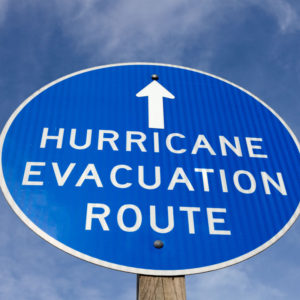
Preston Tobery, Adaptive Tech and Consulting
September 10, 2019
Will Zweigart, Flatbush Cats
September 17, 2019
This week’s guest post comes to us from Liz Pease, former Executive Director of the Merrimack River Feline Rescue Society, who was featured on CCP Episode #51.
As you know from last week’s post, September is National Preparedness Month here in the U.S. Last week, we talked about setting up an emergency kit for your personal pets. This week, let’s talk a little about how you can make sure your shelter (or similar location) is disaster-ready.
 I’ll highlight a few good resources for your organization or group and give you a few other tips I’ve learned along the way. This Animal Sheltering article is a good place to start for an overview of animal disaster planning. The Humane Society of the United States also offers an archived webinar titled Disaster Preparedness Tips for Shelters and Rescues that you may want to check out.
I’ll highlight a few good resources for your organization or group and give you a few other tips I’ve learned along the way. This Animal Sheltering article is a good place to start for an overview of animal disaster planning. The Humane Society of the United States also offers an archived webinar titled Disaster Preparedness Tips for Shelters and Rescues that you may want to check out.
A critical early step in having a disaster plan in place is an evacuation plan. The plan must involve communication protocols as well. You can download a sample of a fairly complex plan for a large organization from ASPCA Pro—or you can come up with your own. Depending on the size of your organization and your location, the plan may be as simple as posting exit route maps in each room, designating a couple of staff members as “disaster point people” to lead a phone tree, and discussing and writing down how you will plan to get all the animals out in case of a disaster, as well as where you’ll take them once they are out.
Be sure to keep in mind that the plan may differ depending on the kind of disaster. In any case, however, you’ll want to be sure to have containment devices of some kind readily accessible in each area of the shelter. At Merrimack River Feline Rescue Society, staff have purchased zippered cloth pillowcases (great for transporting cats in a pinch) and have mounted boxes on the wall of each room with enough cases in them for the maximum number of cats that particular room can hold.
One thing that many organizations, especially smaller ones, overlook is making sure that local law enforcement (police, fire, emergency management) has current contact information for your organization and, ideally, a key to your building. They should also have any special information specific to your facility (like “all cats on second floor are loose, other floors are caged”). At MRFRS, we installed a Knox Rapid Access System box on the front porch—a relatively inexpensive lock box that only the fire department can open, with a key to the building and contact numbers inside. Make sure you give local law enforcement more than one contact person, and be sure to update information and keys anytime you change locks or have staff turnover.
 Another aspect of disaster planning is making sure your staff and volunteers can move safely through the building during a power outage, which is likely to be one of the things most often encountered in a variety of emergency situations. Keep an easy-to-locate box (perhaps marked with glow-in-the-dark tape) in each room stocked with flashlights (headlamps are great for hands-on work with animals, and lantern-type flashlights are great for when you need to illuminate the whole room and have your hands free!), extra batteries, and any other supplies that might be handy to have at your fingertips. If you live in an area that experiences frequent power outages—or if power outages mean that your access to water or heat are limited—consider investing in a generator. Don’t forget to learn how to use it ahead of time, keep extra fuel on hand, and do periodic test runs to make sure it’s working properly.
Another aspect of disaster planning is making sure your staff and volunteers can move safely through the building during a power outage, which is likely to be one of the things most often encountered in a variety of emergency situations. Keep an easy-to-locate box (perhaps marked with glow-in-the-dark tape) in each room stocked with flashlights (headlamps are great for hands-on work with animals, and lantern-type flashlights are great for when you need to illuminate the whole room and have your hands free!), extra batteries, and any other supplies that might be handy to have at your fingertips. If you live in an area that experiences frequent power outages—or if power outages mean that your access to water or heat are limited—consider investing in a generator. Don’t forget to learn how to use it ahead of time, keep extra fuel on hand, and do periodic test runs to make sure it’s working properly.
In planning for disasters, it’s obviously easy to focus on the animals and the people—but don’t forget about a disaster prep plan for less tangible things, too, like data and medical records. Make sure all organizational data is backed up regularly offsite, and make sure that key staff know how to access that data quickly in an emergency.
Consider offering disaster prep workshops (or at least handouts) for your foster homes, or provide them with emergency kits for their foster animals. They can usually treat foster pets as they would their own pets in terms of emergency supplies, but as the owner of the animals, it’s the shelter’s responsibility to make sure they are in a safe location with a good plan for their safety in case of disaster.
Finally, if your shelter is likely to be called upon to help the community in the case of a larger-scale disaster, a good way to figure out where the holes in your plan are is ASPCA Pro’s Animal Emergency Preparedness Self-Assessment Checklist. If this checklist is not scaled to your organization, at the very least, sit down in advance with your local animal control officer and possibly various members of law enforcement to discuss what they expect of you and how you can work together to meet the community’s needs.
Disaster planning can feel overwhelming—but it’s critical. Make a plan to make a plan this National Preparedness Month. Trust me, you’ll sleep easier at night once you do!

Article by Liz Pease. Liz Pease is a freelance writer, editor, and proofreader who spent over a decade at The Merrimack River Feline Rescue Society in Salisbury, MA, first as a program coordinator, then as director of operations, and finally as executive director. She lives in Salisbury with her 4 spoiled cats, her husband, and two young children.




